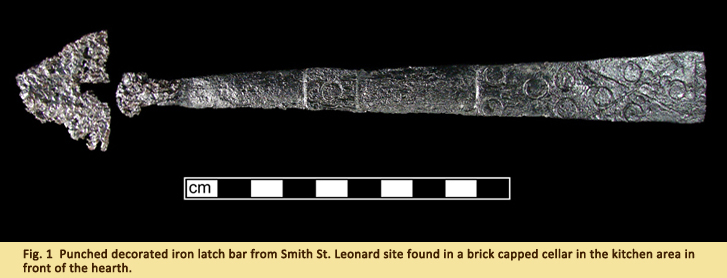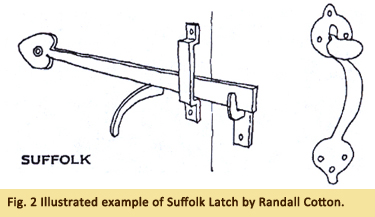Punch-Decorated Door Latch Bar from
Smith St. Leonard Site
November 2013
By Gareth McNair-Lewis, MAC Lab Conservation Technician
In the fall of 2011 at Jefferson Patterson Park and Museum archaeologists discovered an iron door latch bar during excavations at the Smith’s St. Leonard site (18CV91). When the object was cleaned of dirt and corrosion it revealed a surface decoration that is rare for iron but found quite often on tin and pewter ware (Smith 1987). This design is called bold punch work decoration. Punching was a term given to a method of decorating softer metals such as tin. A blunt tool or "punch" was struck with a hammer to produce an indentation on the surface of the metal (Arbor 1994). The Smith's St. Leonard latch bar was found in a brick-capped cellar in front of the kitchen hearth. The cellar, which dates to the mid-eighteenth century, was probably filled in quickly during building renovations (Glass, 2013: pers. comm.).

The latch bar, found in two pieces, has a triangular shaped pivot end with a nail hole in the center (Fig. 1). The length of the object is eight and three quarter inches. Halfway down on the exterior side is a slightly raised square containing one solitary punch decorated circle. Further down the latch is a group of five punched circles and below them a group of four punched circles divided by the incised lines of an X. The very end of the latch bar has a vertical incised line and five shorter horizontal incised lines.
 This latch bar belongs to a type of early eighteenth-century door hardware referred to as "Suffolk" latches (Fig. 2), which were made of five pieces. In an early nineteenth-century treatise, English Metalwork, William Twopenny (1797-1893) coined the names "Suffolk" and "Norfolk" to describe the two most common styles of thumb latches. The Suffolk style has no back plate (Kraumanis 2005). Each part of the Suffolk latch was hand wrought and hand crafted. The five pieces of this particular door latch are the latch bar, the thumb latch, the keeper, the stapler or retainer and the curved grasp, which had flattened ends or "cusps" in many forms, including heart, spade and diamond shaped. These were all hammered out by the blacksmith (Cotton 1987).
This latch bar belongs to a type of early eighteenth-century door hardware referred to as "Suffolk" latches (Fig. 2), which were made of five pieces. In an early nineteenth-century treatise, English Metalwork, William Twopenny (1797-1893) coined the names "Suffolk" and "Norfolk" to describe the two most common styles of thumb latches. The Suffolk style has no back plate (Kraumanis 2005). Each part of the Suffolk latch was hand wrought and hand crafted. The five pieces of this particular door latch are the latch bar, the thumb latch, the keeper, the stapler or retainer and the curved grasp, which had flattened ends or "cusps" in many forms, including heart, spade and diamond shaped. These were all hammered out by the blacksmith (Cotton 1987).
The latch bar is attached horizontally across the door at its hinge or pivot end. About two-thirds of the way across, a staple or retainer holds the latch bar against the door, while its end rests in a keeper beyond the face of the door. On the other side of the door is attached the grasp, which has an upper and lower cusp that were often symmetrical and triangular or heart shaped, and the thumb latch which protrudes through the door. When the thumb latch is depressed on the grasp end, the curved bar extending through the door lifts the latch bar above the keeper and thus the door opens (Cotton 1987).
 Certainly it was a blacksmith who forged and shaped the iron latch, but it was another skilled metal worker, called the "whitesmith", who added the finishing touches and punch work (Fig. 3). The whitesmiths worked primarily with the lighter colored metals such as tin and pewter, producing surface designs along with filing and polishing. Early whitesmith products that exhibit punch work in iron are difficult to find today, partly because they were never common in the first place (Smith 1987).
Certainly it was a blacksmith who forged and shaped the iron latch, but it was another skilled metal worker, called the "whitesmith", who added the finishing touches and punch work (Fig. 3). The whitesmiths worked primarily with the lighter colored metals such as tin and pewter, producing surface designs along with filing and polishing. Early whitesmith products that exhibit punch work in iron are difficult to find today, partly because they were never common in the first place (Smith 1987).
| References |
|
| Arbor, Marilyn |
| 1994 |
Tool and Trades of America's Past. The Mercer Museum Collection. |
|
| Cotton, J. Randall |
| 1987 |
Knobs and Latches. Old House Journal. |
|
| Glass, Alex |
| 2013 |
Personal communication – Maryland Archaeological Conservation Laboratory. |
|
| Kraumanis, Sven |
| 2005 |
Three Centuries of Door Hardware. Legacy Vintage Building Materials and Antiques. |
|
| Smith, Elmer L. |
| 1987 |
Early Iron Ware. Applied Arts Publishers. |
|